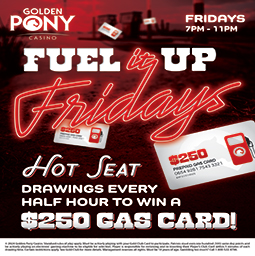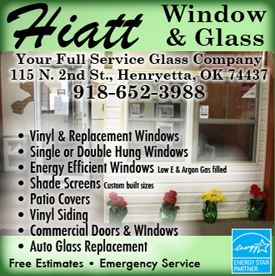
U. S. highway 75 was the Weleetka main street for about five blocks. I suppose there was another way to get through town, but Weleetka was quite small, and still is, so I don't know if there was, or how highway traffic made it through town during the festival if there wasn't.
The highlight of the festival always came after dark when a truckload of watermelons arrived and men began giving them to the crowd. They could be eaten at the street tables or taken home. Utensils weren't furnished, so it was up to people to bring their own, and after they cut them open, eat them politely or the juicy way with faces and ears inside the melon.
In 1940 when I was 10, my parents took my sisters and me to the festival and we had a big time. We might have had a carnival ride or two, but most of our time was spent walking around marveling at the side shows, fiddling, street dancing, and waiting for the watermelon truck. I know that at that age I didn't dive from the 20 foot board at the town swimming pool at the end of the main street. Until I was in high school, all I did was jump from it. Diving had to wait until I did it later in my high school days, and even then, I don't think I actually "dove" more than a few times. Henryetta's highest board, even at Nichols Park, was just 14 feet and I started diving from it fairly early, but maybe not until junior high.
When the watermelon truck arrived, the crowd closed in as men worked to get it situated at just the right spot to begin giving melons away. That took quite a while as the crowd had to be persuaded to give up what they had thought would be positions where they would be among the earliest to get a melon. Finally, when it appeared that it was about in position, two boys, about 15 years old, climbed the truck's side, jumped in, grabbed a watermelon apiece, jumped out of the truck, and started running. The police, with help from enough men that it looked like a western posse, started chasing them. In the end, the boys got away.
I was just a kid, but I hadn't arrived in town on the back of a goose, so I wondered - if the watermelons were to be given away, why were adults chasing boys for "stealing" some. And if they were to be given away, were they "stealing" them, anyway? And why did boys jump in the truck to "steal" watermelons that were soon going to be given to them? As I grew up, I realized why. The two boys were black, and that is why the "posse" was chasing them. Sadly, blacks were treated very differently in those days and still are by some people.
MEDICINE SHOWS
Before World War II, medicine shows with small troupes of performers traveled the country and performed nightly in small towns for a week or so. A free show was held in an open tent with a stage and bench seating for about 100 - 150. Medicine Show troupes had about 6-7 people that traveled in a few vehicles hauling the equipment, stage, tent, and seating.
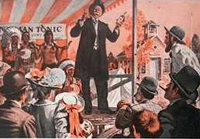 I don't know if they had advance advertising - they might have just shown up, rented space, and let knowledge of the show get around by word of mouth. Those that showed up in Henyetta usually set up in a vacant lot near the west end of Main.
I don't know if they had advance advertising - they might have just shown up, rented space, and let knowledge of the show get around by word of mouth. Those that showed up in Henyetta usually set up in a vacant lot near the west end of Main.When the nightly show began, "Doc," the master of ceremonies, started a series of acts consisting of banjo players, fiddlers, jugglers, magicians, tumblers, contortionists, etc. After a few acts, he stopped the show and started govomg a pitch extolling the wonders of a medicine he'd created from his own secret mixture.
It was the elixir of the ages. It'd cure anything - coughs, heartburn, backaches, pains of all kinds, tiredness, etc. If you had it, it'd cure it. If you didn't, you needed some of it to have when you caught something. A few minutes into the pitch, troupe performers began offering bottles of it for sale in the audience as Doc continued his pitch.
When sales slowed, Doc restarted the acts. After a few more acts, he stopped them again and the sales pitch and sales resumed. Sometimes they had "testimonials" from people (shills?) who'd been cured of dire things.
Shows lasted two or three hours, or as long as Doc thought more sales could be made to that night's audience. Even though this was before World War II ended the hard grip of the great depression, people with practically nothing bought his overpriced cure-all like it was the marvel of all time, based solely on claims of a huckster. In "The Wizard of Oz", Henry Morgan played the part of a traveling medicine show man. Early in the movie, Dorothy met him at his one man show wagon. Later, as the Wizard, he was shown to be a spellbinder - like the medicine show Docs
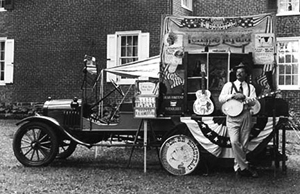 .
.Since shows were in summer and held fairly near downtown, kids in various neighborhoods could get their parents to let them go in groups. (It wasn't as dangerous for children to be out at night in those days.)
A few parents probably went along since the kids might have trouble getting seats unless potential customers were with them.
For kids, and even for adults, the acts were a delight. Sometimes they even had audience participation - like in a short boxing match in which I saw a kid who was the son of one of the troupe, box and lose to a Henryetta boy who was later one of my HHS 1948 classmates and is still a friend with which I have fairly frequent contact.
I
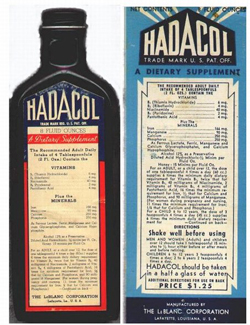 t was amazing to see how many bought the magic elixir, but it had a high alcohol content - and Oklahoma in those days was still a dry state where it was illegal to sell even beer with more than 3.2 alcohol content.
t was amazing to see how many bought the magic elixir, but it had a high alcohol content - and Oklahoma in those days was still a dry state where it was illegal to sell even beer with more than 3.2 alcohol content. Some who bought it were so eager to start the cure they took doses as soon as they bought it. As the show went on, they became an outstandingly happy crowd as the "cure" set in and people had more doses.
Some bought more than one bottle in case they needed more cure. It could be that the police just let it go because of the entertainment. Some off-duty ones might even have been in the audiences. (During Oklahoma's dry days, authorities were sometimes lax in enforcing laws against bootleggers, too, but that is a different story.)
Medicine shows, like many things, ended during World War II. A few resumed after the war, but couldn't compete with movies in air conditioned buildings. The last medicine show of any significance sold "Hadacol" that was made by a man who, when questioned about the name, said "I hadda call it something." Hadacol's run ended in 1951 when it was revealed to be 12% alcohol. Running medicine shows wouldn't yield enough revenue to be worth putting on today, but they were quite the thing in their time.









